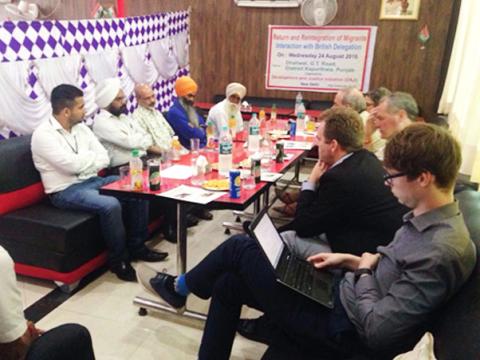Migration is a significant human activity. It continued all through history and took many different forms influenced by the transportation technology of the time, channels of information, income disparities, opportunities for employment and businesses and freedom of movement regimes. While people migrate within national boundaries it is international migration that is more significant from a human rights perspective and has global implications. Even as migration grew with better communication technology, cheaper travel and informed choices for migration, hardening of state boundaries and racist policies led to restrictive migration regimes. At the same time, due to high demand in underdeveloped and developing countries to migrate to lucrative and safer destinations, businesses of traffickers and people smugglers have grown. Migrants pay high amounts to these traffickers and suffer worst human rights violations.
There are over 258 million migrants around the world living outside their country of birth. While substantial part of this migration happens through regular channels, there is also a worrying trend of irregular migration of workers. It is such workers who travel without the necessary paperwork or live in foreign destinations without valid permissions. Globally 10-15% of international migrants are in an irregular situation.
Migration governance has been difficult process due to the sensitive nature of migration, its implications for domestic labour, foreign policies and border controls. It is also a tricky exercise as often forced displacement and refugee movement is mixed with economic migration. At first instance refugees are often indistinguishable from economic migrants. While refugees are protected by the 1951 UN Convention on Refugees and Protocol, 1967, economic migrants cannot claim similar protection.
Therefore, clear policies are needed to protect refugees even while international economic migration is regulated in a framework that not only protects the human rights of migrants but also allows states to secure their borders and combat people smuggling. Towards this end, the UN General Assembly decided In September 2016 to develop a global compact for safe, orderly and regular migration. This was done through the adoption of the New York Declaration for Refugees and Migrants. While the Global Compact on Refugees was officially affirmed by the United Nations General Assembly global in December 2018, UN Member States only finalized the text of the Global Compact for Safe, Orderly and Regular Migration in July 2018.
The global compact on migration has 23 objectives on different aspects including that ‘to minimise adverse drivers and structural factors that compel people to leave their country of origin’ (2), migrants have proof of legal identity and adequate documentation (4), address and reduce vulnerabilities in migration (7), prevent, combat and eradicate trafficking in persons in the context of international migration (10), use migration detention only as a measure of last resort and work towards alternatives (13), cooperate in facilitating safe and dignified return and readmission, as well as sustainable reintegration (21).
The proportion of irregular migrant workers for India is even greater. One-third of the international migrants from India are estimated to be in irregular situation. Many of them are apprehended in foreign countries for status related offences. Indian passport authorities receive nearly 25,000 nationality verification enquiries annually from India’s missions abroad.
Most irregular migration takes place through the network of human smugglers and agents. Migrants and their families pay a heavy price for getting transported to foreign lands in search of better jobs and opportunities. Expanding social networks, better and cheaper communication, and availability of easy transport in the last two decades have further contributed to increased volume of international migration – both regular and irregular. This volume is projected to increase. By 2040-2050, India, together with Mexico and China will constitute three top net emigration countries with many migrants aiming to migrate to three top net immigration countries – the UK, USA and Canada.
Irregular/ undocumented migration creates tremendous hardships for the migrant workers in destination countries. Lacking legal identity, they are forced to live reclusive lives in inhuman conditions. They eat in places of religious worship and sleep on streets and are exploited by employers in these destinations. Unable to fulfil their aspirations for comfortable lives in foreign destinations, many migrants return to India with serious mental health and addiction issues.
A larger volume of Indian labour migration takes place to the Gulf Cooperation Council (GCC) countries comprising Saudi Arabia, Kuwait, Qatar, Bahrain, UAE, and Oman. Close to 8.75 million Indian migrant workers live in the six GCC countries, as of 2022. India is the top remittance receiving country with $87 billion in remittances in 2021-2022; 30% of this amount is estimated to come from migrant workers in the GCC countries. This statistic has declined from 50% in 2016-2017. This sizeable decline can be attributed to the COVID-19 pandemic. But the numbers of migrants moving to GCC countries are again on a rise. An overwhelming majority of them being are male, usually the main breadwinners of their families.
While Indian migrant workers – whether regular or irregular – in foreign destinations face different types of challenges, those who return from these destinations too face difficulties in reintegrating into the local economy and their families. They need support to be able to successfully reintegrate after their return. The needs of undocumented migrant workers and greater than those who migrate through regular channels and are legally able to return to India

